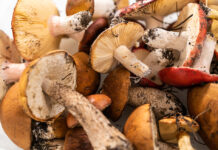
Could added ingredients be the source of your food intolerance?
BY CAYLA RAMEY
If your grocery list was made up of the ingredients used in your favourite packaged goods, would you know what you were shopping for? With the amount of food additives in today’s pre-prepared foods, you probably wouldn’t.
Not only has this phenomenon required a lot more label reading on your part—it has actually caused an increase in food intolerances and allergies. The worst part? This spike has also made it di cult to pinpoint what ingredients, exactly, are causing consumers so much discomfort.
IS GLUTEN REALLY TO BLAME?
Since gluten is extremely common in our food, it is often the first additive medical professionals point to as the source of these sensitivities. In the past five years, this has created an upshot in gluten intolerance and celiac diagnoses. With this, the gluten-free diet has become something of an epidemic.
The trouble is, the symptoms associated with gluten intolerance are very similar to those caused by other food sensitivities. With a buildup of gas in the intestinal tract, all food-intolerant individuals often experience severe bloating and sharp stomach pains. This means that it can be extremely diffcult to pinpoint what, exactly, you are sensitive to—especially when your allergy is to a common additive, rather than a specific food protein.
TAKE CARE WITH CARAGEENAN
Like gluten, carrageenan is an extremely common food additive. And, as with gluten, many individuals are intolerant to it. This family of chemical compounds, sourced from edible sea- weed, has been used throughout history—especially in Ancient China—as an alternative to gelatin. Now, it is used to thicken, stabilize, or bind foods, such as baked goods, baby formulas,
yogurt, ice cream, juice, low-fat dairy products, dairy alternatives, and processed meats.
There are three types of carrageenan: Kappa carrageenan, which reacts with the protein and potassium in dairy to form a dense gel; Iota carrageenan, which reacts with calcium to make a soft gel; and Lambda carrageenan, which thickens products.
Carrageenan is very hard to digest—especially for those who have other food intolerances. It promotes so much irritation in the GI tract that it is often used in scientific studies to induce symptoms of inflammation in the gut.
In fact, in a study on animal subjects, it was concluded that “…carrageenan [has] been associated with the development of intestinal ulcerations that resemble ulcerative colitis…The potential role of carrageenan in the development of gastrointestinal malignancy and inflammatory bowel disease requires careful reconsideration of the advisability of its continued use as a food additive” (Tobacman, 2001).
The American Journal of Physiology has also made note of these issues, stating, “exposure of human intestinal epithelial cells to carrageenan triggers a distinct inflammatory path- way…the study findings may represent a link between genetic and environmental etiologies of inflammatory bowel disease” (Borthakur et al., 2006).
As such, you may want to look into what could actually be behind your food sensitivities. Then, avoid the triggering foods. Because these additives are in so many products, the best thing for you to do is read the ingredients. As with anything, it’s all about doing proper research. VM











